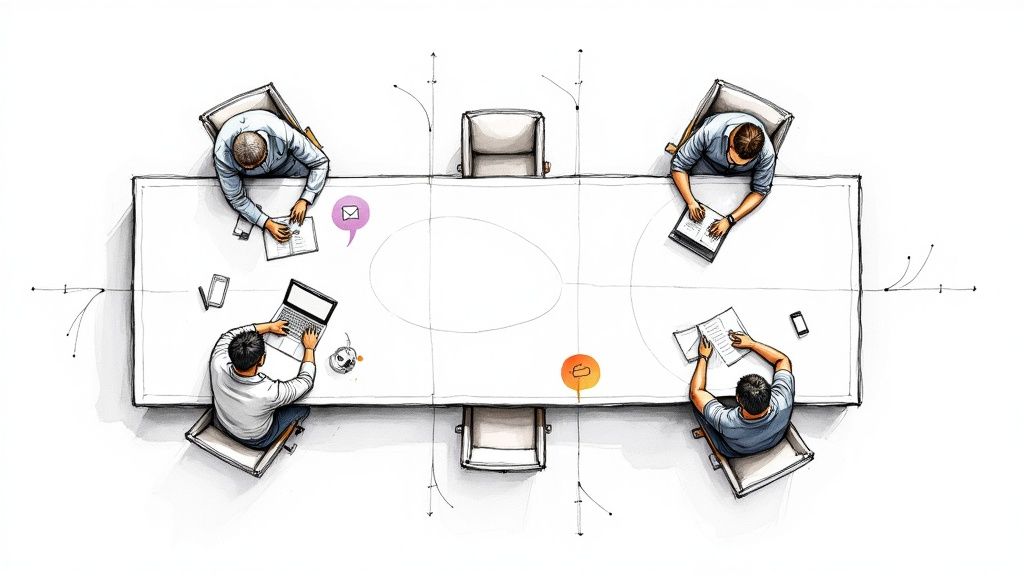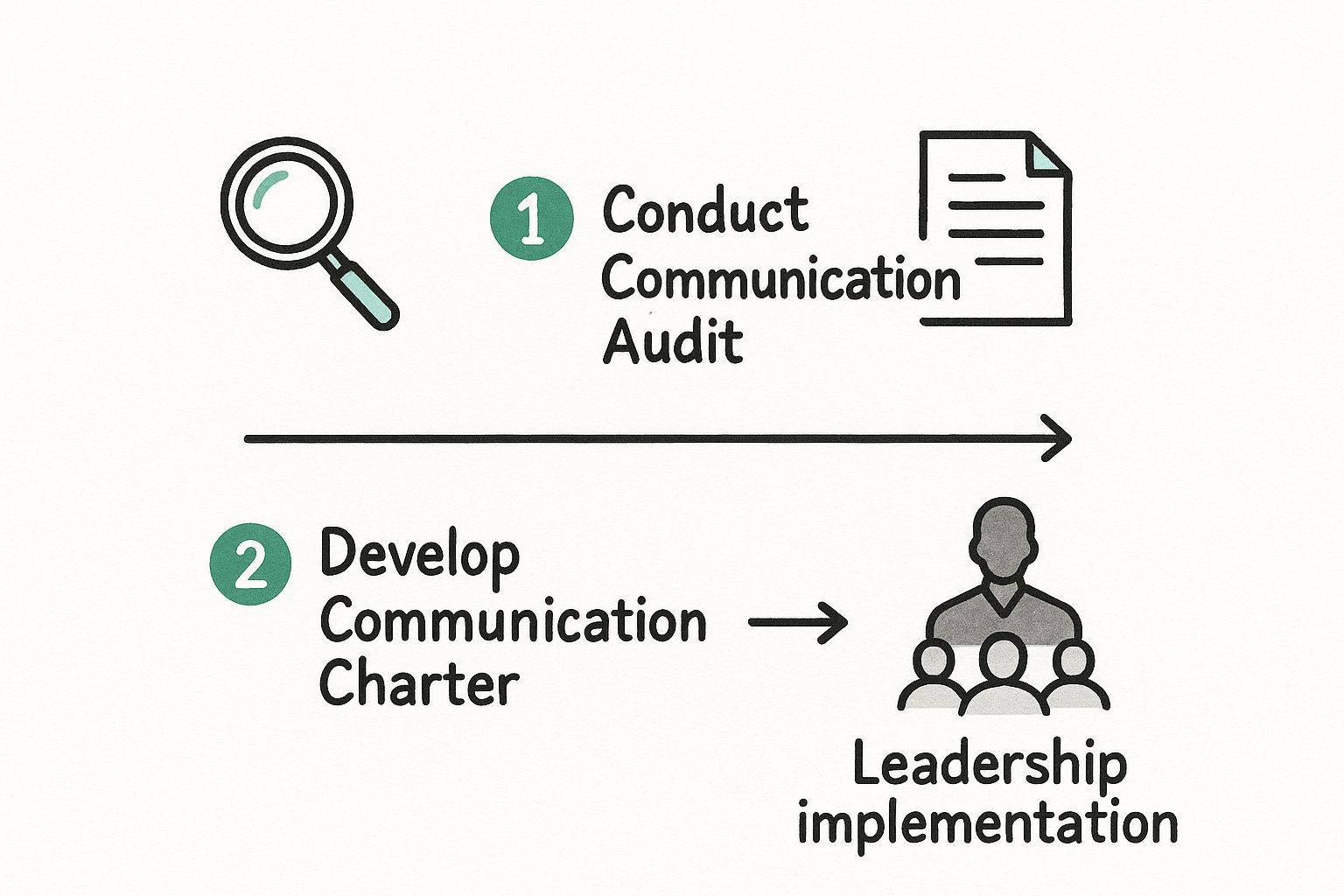How to Improve Business Communication for Better Results

Poor communication is more than just an annoyance. It’s a silent drain on productivity, morale, and your bottom line. We've all been there: a single vague email spirals into a week of rework, derailing an entire project and leaving everyone frustrated.
This isn't just about avoiding simple mistakes; it's about building a significant competitive advantage. When messages get lost in translation, the costs stack up fast. In fact, studies show it's a multi-trillion-dollar problem globally.
For example, companies in the United States lose a staggering $1.2 trillion every year due to poor communication. That number is the sum of countless inefficient emails and unclear project goals. When 86% of executives and employees blame communication breakdowns for workplace failures, it's impossible to ignore.
Why Better Communication Is Your Biggest Advantage

This guide breaks down how you can improve business communication into four core pillars. Mastering these areas will transform confusing requests into clear, actionable tasks and foster a culture where your team genuinely wants to collaborate.
Here’s a quick overview of what we'll be covering.
The Four Pillars of Improved Business Communication
| Pillar | Core Principle | Key Benefit |
|---|---|---|
| Clear Messages | Say what you mean, simply and directly. No jargon, no ambiguity. | Reduces errors, saves time, and ensures everyone is on the same page. |
| Constructive Feedback | Create a culture where feedback is a tool for growth, not criticism. | Builds trust, improves performance, and accelerates professional development. |
| The Right Tools | Select technology that supports clear communication, not complicates it. | Streamlines workflows, enhances collaboration, and keeps information accessible. |
| Consistent Strategy | Develop and stick to a company-wide communication plan. | Creates predictable, reliable processes that eliminate confusion and friction. |
By focusing on these four areas, you can build a more resilient and effective team from the ground up.
Moving Beyond "Soft Skills"
For too long, communication has been dismissed as a "soft skill." That term completely undersells its value, making it sound like an optional extra rather than what it really is: a core operational competency.
The truth is, clear directives and transparent feedback are the engine of any high-performing team. Whether you're a content creator drafting a client email or a marketer refining AI-generated ad copy, your success depends on how well your message is understood.
Great communication is the lubricant that keeps the machinery of business running smoothly. Without it, friction builds, progress grinds to a halt, and talented people look for the exit.
This guide is designed to give you concrete strategies you can put to work immediately. Whether you’re a student, a professional, or a marketer using AI to get a first draft done, the goal is the same: to get your message across with precision and impact.
We’re going to dig into the pillars that create a culture of clarity, including:
- Clarity and Conciseness in every single message.
- Constructive Feedback Loops that build people up, not tear them down.
- Strategic Tool Selection to support your workflow, not get in the way of it.
- Actionable Implementation Plans to make sure these changes actually stick.
Polishing your own writing is always the best place to start. If you're looking to level up your messaging, our guide on how to improve English writing skills is packed with practical tips.
Here at PureWrite, we believe in authentic, human-led communication, especially as AI becomes a bigger part of our work lives. We want to help you use AI writing tools ethically to enhance your unique voice, never to replace it. Ready to turn those AI-generated drafts into something clear and compelling? Try PureWrite to humanize your AI content.
Make Your Message Impossible to Misunderstand

Here’s a simple truth: great business communication isn't about sounding smart; it's about being impossible to misunderstand. Whether you're sending a quick email or leading a team meeting, clarity is the goal. It cuts through the noise and gets things done.
Too often, we hide our message behind dense paragraphs and vague corporate jargon. The result? People get confused, skim, or just ignore what we've sent. Let’s change that with some practical advice.
Taming the Email Beast
Think about the last email you actually enjoyed reading. It was likely short, direct, and had an obvious point. You can make your own emails just as effective.
It starts with the subject line—make it a mini-summary of the email. Then, get straight to the point in the first sentence. This respects your reader’s time and immediately tells them why you're in their inbox.
Break up longer thoughts into short, scannable paragraphs (2-3 sentences). Use bullet points for action items or lists. If you want a refresher on keeping things direct, these examples of simple sentences are a great starting point.
Vague requests get vague results. A clear, direct ask respects everyone's time and dramatically increases the likelihood of a swift and accurate response.
Let's look at a real-world example for content creators. Imagine you're a writer asking a client for feedback.
- Before (Vague): "Here's the first draft of the blog post. Let me know what you think."
- After (Clear and Actionable): "Here is the first draft of the 'How to Improve Business Communication' blog post. Could you please review it by EOD Friday and let me know if the tone is right and if the examples are a good fit for your audience?"
See the difference? The second version is a blueprint for action. It specifies the what and the when, leaving no room for guesswork. This is how you drive results, one message at a time.
Speaking with Purpose
The same rules apply when you communicate verbally. Before walking into a meeting or jumping on a call, take thirty seconds to organize your thoughts. It will keep you from rambling and ensure you hit your key points.
We recommend a simple "think-first" framework:
- Pinpoint Your Core Message: What is the one thing they absolutely must know? Lead with that.
- Add Just Enough Context: Give them the background they need, but don't drown them in details.
- State Your "Ask" Clearly: What do you need? A decision? Feedback? A specific action?
This structured approach turns meandering conversations into productive working sessions where everyone walks away knowing exactly what comes next.
In the end, it all comes down to clarity. If you're using AI to help draft communications, it’s vital that the final text sounds authentic. Give PureWrite a try to humanize your AI-generated content and make sure your message always connects.
How to Build a Culture of Constructive Feedback

Great communication is more than just sending clear messages; it's about creating an environment where people feel safe enough to receive them. Feedback is the fuel for growth, but it only works in a culture of psychological safety.
Your team members have to know they can speak up, make mistakes, and offer honest thoughts without fear of being shut down. When that foundation of trust is there, feedback stops being a dreaded annual review and becomes a collaborative tool everyone can use to get better.
A Go-To Framework for Giving Feedback
One of the most powerful tools for delivering feedback is the Situation-Behavior-Impact (SBI) model. It's brilliant because it strips away personal feelings and focuses on what actually happened, turning a potentially awkward conversation into a productive one.
Here’s the breakdown:
- Situation: Pinpoint the specific "when" and "where." This grounds the feedback in a real, concrete moment.
- Behavior: Describe the exact actions you observed. The key here is to be objective and avoid assumptions about their intentions.
- Impact: Explain the ripple effect of that behavior. How did it affect you, the team, the project, or the customer?
Let's see it in action. Instead of saying something vague and accusatory like, "You were late with the report, and it was really unprofessional," try the SBI approach:
"During the (Situation) project wrap-up meeting this morning, I noticed that (Behavior) the final analytics report wasn't submitted by the 9 AM deadline. The (Impact) was that we couldn't include the latest numbers in our client presentation, which meant we had to reschedule our debrief."
See the difference? It's direct, professional, and focuses entirely on the work. This opens the door for a problem-solving discussion instead of putting someone on the defensive.
Receiving Feedback: The Other Half of the Equation
Of course, giving good feedback is only half the battle. Learning how to receive it is just as critical. The biggest challenge is to simply listen without immediately jumping to defend yourself.
The next time someone gives you feedback, thank them for it. Ask a few clarifying questions to make sure you really understand. Then, give yourself a moment to actually process what they said before responding.
This single skill can completely change your relationship with feedback. It also signals to your team that you value their perspective, which makes them more open and honest in return.
The link between open communication and job satisfaction is undeniable. A recent report found that a staggering 63% of employees are considering leaving their jobs because of poor communication. You can dig into more of these numbers and learn how empathy impacts workplace dialogue.
Building this kind of culture takes time and consistent effort. As you start using AI to draft emails or reports, remember that the human touch—the empathy and tone—is what makes communication truly work. We can help you find that balance. Try PureWrite to ensure your AI-assisted writing always sounds authentic and constructive.
Choosing the Right Communication Tools and Channels
https://www.youtube.com/embed/Hrm9Eic2-n0
A great communication strategy won’t get you far without the right technology to back it up. Looking at the sea of communication apps available today, it’s easy to feel overwhelmed. The real goal isn't to chase every new tool; it's about hand-picking a few key platforms that actually fit how your team works.
The best communicators match the tool to the task. A critical update that gets buried in a noisy Slack channel probably should have been a formal email. Getting this right cuts down on confusion and makes everyone more productive.
Matching the Channel to the Message
Before you fire off a single word, take a second to think about what you’re trying to accomplish. This small habit can save you—and your team—a world of frustration. The channel you choose sends its own message.
Here’s a simple framework that works wonders for teams trying to get organized:
Email for Formal Records: Stick with email for the important stuff—official announcements, detailed project briefs, and any client communication. It’s built for asynchronous communication, giving people the space to think before they respond.
Instant Messaging for Rapid Problem-Solving: This is where tools like Slack or Microsoft Teams shine. Use them for quick questions, bouncing ideas around in real time, and getting urgent updates out to the team immediately.
Project Management Tools for Task Updates: Platforms like Asana, Trello, or Jira are designed to keep conversations tied directly to the work. All your progress updates and questions about specific deliverables belong here.
The best communication stack isn't the one with the most apps. It's the one with the right apps, used with clear guidelines that everyone understands. When the whole team knows why they're using a specific channel, the entire workflow just clicks into place.
Weaving in AI to Sharpen Your Communication
Technology is always changing the way we connect, and right now, generative AI is leading the charge. When you use it thoughtfully and ethically, AI can be an incredible partner in communicating more clearly. It can summarize a long meeting transcript or help you draft a more concise email.
However, research shows that while 73% of knowledge workers say generative AI has helped them prevent miscommunications, AI-generated text can often be easy to spot. Studies have shown AI detection tools can identify AI writing with over 90% accuracy in some cases, which can harm your credibility if you're not careful. You can dig into more data on how technology is reshaping workplace communication on project.co.
Here’s the catch: AI should always be there to support human connection, not replace it. An AI-generated draft is a fantastic starting point, but it almost always lacks the nuance and personality crucial for building strong professional relationships. Always review, edit, and add your authentic voice.
That’s exactly where we can help. PureWrite is designed to help you polish AI-generated text so it sounds authentic and connects with people. If you’re trying to make your automated drafts feel more human, our guide on how to humanize AI text for free is a great place to start.
Putting Your Communication Strategy into Action
Knowing how to improve business communication is one thing; actually doing it is another. A great communication strategy can't just be a document collecting dust on a shared drive. It has to live and breathe in the daily habits of your team.
The best way to start is by figuring out where you currently stand. We recommend a simple communication audit. Just ask your team a few direct questions: "Where do our communication breakdowns happen most often?" or "Do our current tools actually help you?" This gives you a clear, honest starting point.
Creating Your Communication Charter
Once you've pinpointed the real pain points, it's time to build a "Communication Charter." Think of this as a simple, practical guide that sets shared expectations for everyone. It’s not about adding rigid rules; it's about creating clarity and cutting down on daily friction.
Your charter should cover a few key areas. For instance:
- Channel Guidelines: Get specific about which tool is for what. A good rule of thumb might be: Slack for quick, urgent questions, email for formal client-facing updates, and a tool like Asana for project-specific tasks and feedback.
- Response Times: Setting realistic expectations here is a game-changer. A simple guideline like a 24-hour turnaround for non-urgent emails can seriously reduce team-wide anxiety.
- Meeting Etiquette: Lay down some ground rules, like requiring an agenda for every meeting invitation or establishing "no-meeting Fridays" to protect everyone's focus time.
These guidelines create a solid foundation for consistent, professional communication. If you want to brush up on the fundamentals of clear writing, our guide on basic grammar rules is a great place to start.
This whole process can be broken down into a simple, three-part flow.

As you can see, a successful strategy starts with diagnosis (the audit), moves to documentation (the charter), and is sustained by active leadership.
The Critical Role of Leadership
Let's be honest: a communication charter is only as good as the leaders who actually live by it. When managers and team leads model the right behaviors—like respecting response times and using the designated channels—the rest of the team naturally follows suit.
This is what turns a well-intentioned plan into a real, lasting cultural shift.
As you put these new habits into practice, especially when using AI to help draft internal announcements, it's vital that the final message sounds like it came from a person. At PureWrite, we specialize in helping you humanize AI-generated text, ensuring you never lose that crucial element of genuine connection. Try PureWrite today to bring clarity and a human touch to your communication strategy.
Frequently Asked Questions About Business Communication
We've covered a lot of ground, from crafting a clear message to rolling out a full communication strategy. To wrap things up, let's tackle a few of the questions we hear most often.
What Is the Single Most Important Skill?
If we had to pick just one, it would be active listening. It’s the bedrock of everything else. So many people think communication is about talking, but it really starts with listening.
Active listening is about giving someone your full attention, absorbing their message, and even catching the non-verbal signals they're sending. When you truly master this, you build real trust and make people feel genuinely heard.
How Can I Improve Communication in a Remote Team?
With remote teams, you have to be deliberate. A vague comment that you could clear up in two seconds by the coffee machine can spiral into a major roadblock when everyone is in a different time zone.
Here’s what we’ve found works best:
- Create a communication charter. Seriously, write it down. This simple document sets the rules of the road: when to use Slack versus email, what counts as "urgent," and so on. It removes the guesswork.
- Lean on video for the tricky stuff. For any complex or sensitive conversation, jump on a video call. Seeing faces and reading body language eliminates so much of the misinterpretation that’s common with text.
- Build a virtual water cooler. You need a place for the non-work stuff. A dedicated Slack channel for random thoughts or weekend plans helps build the personal bonds that make a team feel like a team.
When in doubt, over-communicate. It’s almost always better than the alternative in a remote setup.
How Do I Measure the Success of These Initiatives?
You can absolutely measure this, and it’s a mix of hard numbers and human feedback. On the quantitative side, you can look for fewer project delays or quicker response times on important emails. If you're tightening up your team's writing, setting a standard with resources on how to write professional emails can give you a clear benchmark.
But the real story often comes from qualitative feedback. Anonymous employee surveys are invaluable here. Ask direct questions like, "On a scale of 1-10, how clear are your team's goals?" or "Do you feel comfortable providing feedback to your manager?"
Seeing those scores climb over a few quarters is one of the best indicators you'll get. It tells you that your efforts are genuinely making a difference in how people feel and work together.
As you put these ideas into action, remember that making your writing clear and authentic is crucial, especially if you're using AI to help with the first draft. At PureWrite, we specialize in refining AI-generated text into polished, human-sounding content that truly connects.
Ready to see the difference? Try PureWrite for free at https://purewrite.io.